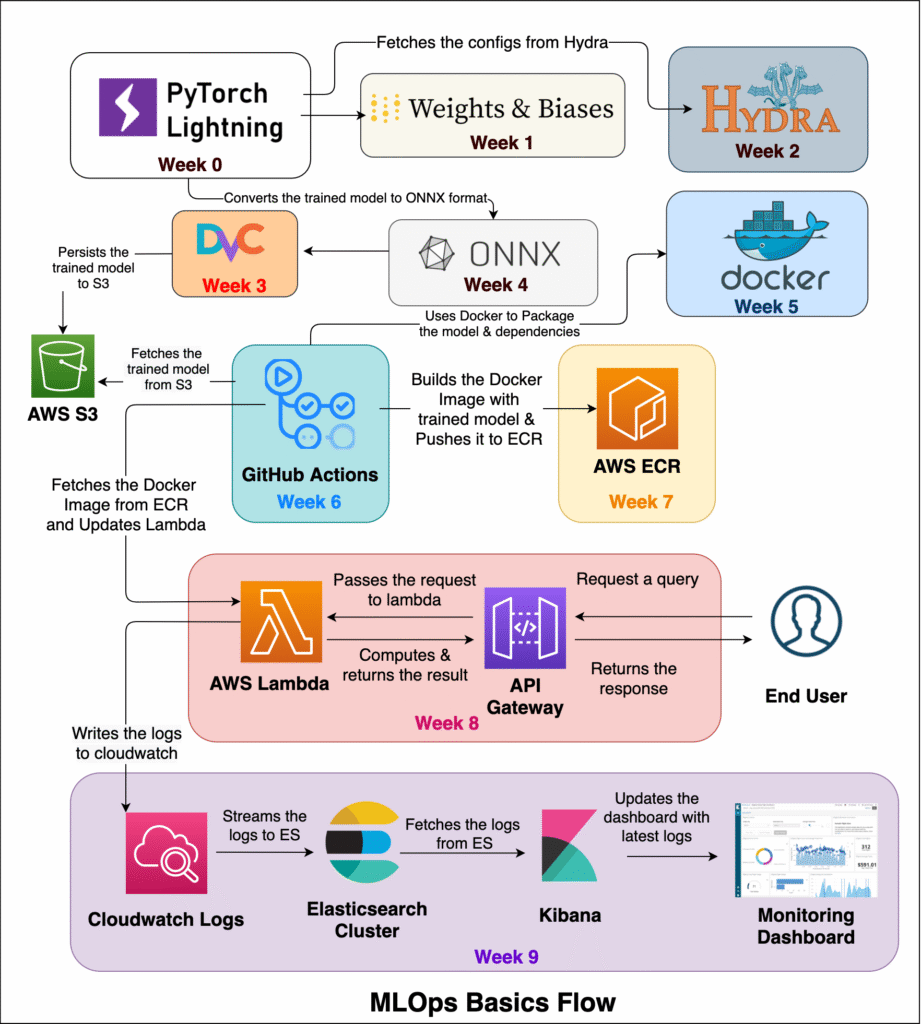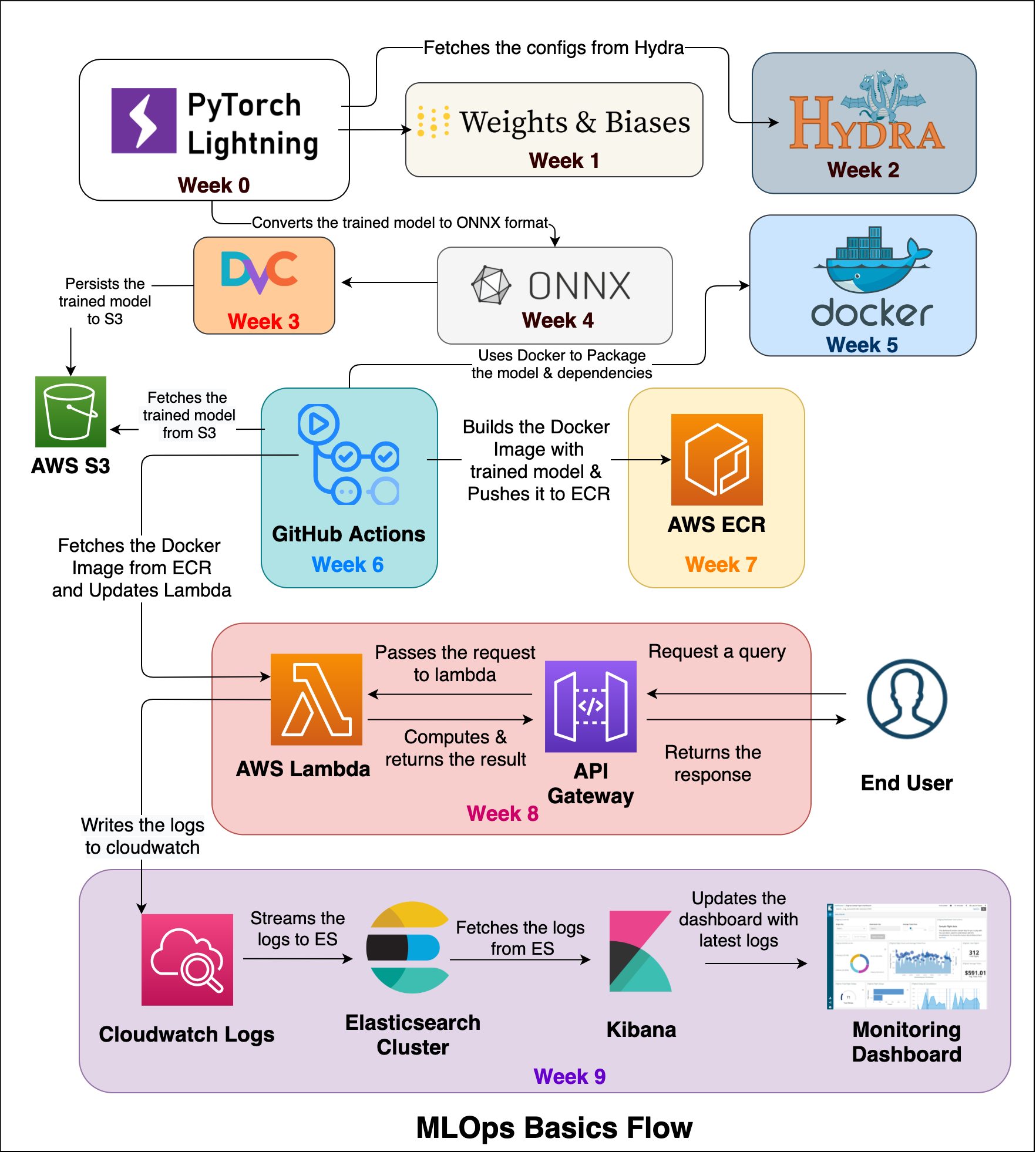Building a machine learning (ML) model is just the beginning of the journey. The real challenge lies in taking that model to production, maintaining it over time and ensuring it continues to perform reliably in real-world scenarios. This is where MLOps comes into play. To help beginners and practitioners navigate this complex process, the open-source MLOps-Basics repository by Raviraja Ganta offers a structured, hands-on approach to learning end-to-end ML operations.
In this blog, we will talk about the fundamentals of MLOps, explore key tools like Hydra for configuration management and DVC for data version control, and show how projects like MLOps-Basics simplify learning these concepts for beginners.

Image Source : MLOps-Basics Github Repo
What is MLOps-Basics?
MLOps-Basics is a GitHub repository designed to teach the fundamentals of MLOps through a simple classification problem. Instead of overwhelming learners with abstract concepts, it provides a step-by-step, week-by-week learning path that covers everything from data processing and model training to deployment and prediction monitoring.
By the end of the journey, users will not only understand how to build ML models but also how to scale, monitor, and maintain them in production.
Explore the repository here: MLOps-Basics on GitHub
Key Features of MLOps-Basics
1. Weekly Learning Modules
The repository is structured into 10 weekly modules, each focusing on a core aspect of MLOps:
- Week 0: Project Setup – Data acquisition, preprocessing, dataloaders, model declaration, training and inference.
- Week 1: Monitoring with Weights & Biases (W&B) – Track metrics, visualize samples and monitor performance.
- Week 2: Configuration Management with Hydra – Manage multiple configurations efficiently and ensure reproducibility.
- Week 3: Data Version Control with DVC – Version datasets and models, track changes and use remote storage.
- Week 4: Model Packaging with ONNX – Convert models to ONNX format for cross-platform compatibility.
- Week 5: Containerization with Docker – Package ML models into containers for consistent deployment.
- Week 6: CI/CD with GitHub Actions – Automate testing, building and deployment pipelines.
- Week 7: Container Registry with AWS ECR – Store and manage Docker images on the cloud.
- Week 8: Serverless Deployment with AWS Lambda – Deploy containerized models in a serverless architecture.
- Week 9: Prediction Monitoring with Kibana – Track predictions, detect data drift and visualize results.
This modular format ensures that learners can follow a progressive, hands-on path instead of tackling everything at once.
2. Hands-On Learning with Jupyter Notebooks
Each module comes with Jupyter notebooks and examples so users can directly implement concepts while learning. This bridges the gap between theory and practice, giving learners real-world experience.
3. Industry-Standard Tech Stack
MLOps-Basics integrates widely used ML and DevOps tools, making it relevant for real-world projects:
- Model Development: PyTorch Lightning, HuggingFace Transformers, HuggingFace Datasets
- Experiment Tracking: Weights & Biases (W&B), TorchMetrics
- Configuration Management: Hydra
- Data Versioning: DVC
- Packaging & Deployment: ONNX, Docker, GitHub Actions, AWS Lambda, AWS ECR, S3
- Monitoring: Kibana, ElasticSearch, CloudWatch Logs
By learning these tools in a structured way, developers gain job-ready skills for modern AI workflows.
4. Scalable and Modular Approach
The repository is designed to be flexible. Beginners can start with basics like model training and monitoring, while advanced users can jump directly into modules such as CI/CD or serverless deployment. This makes MLOps-Basics useful for both individual learners and teams.
Why MLOps-Basics Matters
Many ML projects never make it to production or fail shortly after deployment because they lack proper operational practices. Common issues include:
- No version control for datasets and models
- Lack of monitoring to catch data drift
- Manual and error-prone deployment processes
- Inconsistent environments across development and production
MLOps-Basics addresses these challenges by teaching best practices for reproducibility, automation, monitoring and scalability. Practitioners who master these workflows can:
- Deploy models confidently in real-world environments
- Detect anomalies before they cause failures
- Save costs with efficient CI/CD pipelines
- Scale AI systems while ensuring reliability
Getting Started with MLOps-Basics
To start your journey:
- Clone the repository:
git clone https://github.com/graviraja/MLOps-Basics.git
cd MLOps-Basics
- Install dependencies based on the module you’re working on (e.g., PyTorch Lightning, ONNX, Docker).
- Follow weekly Jupyter notebooks to implement workflows step-by-step.
- Experiment with Docker and AWS integration for deploying and monitoring your own models.
By following the structure, you’ll progress from basic ML pipelines to production-ready deployments.
Conclusion
The MLOps-Basics repository is more than just a tutorial – it’s a practical roadmap for mastering machine learning operations. Its structured weekly approach, real-world examples, and industry-standard tools make it a go-to resource for anyone serious about deploying ML models effectively.
Whether you are new to MLOps or looking to strengthen your production workflows, MLOps-Basics equips you with the skills needed to build, deploy and monitor scalable AI systems.
In an era where reliable deployment is just as important as model accuracy, MLOps-Basics bridges the gap between machine learning and real-world operations.
Related Reads
- LLaMA-Factory: Simplifying Fine-Tuning for 100+ Large Language and Vision Models
- RAGFlow: Revolutionizing AI with Retrieval-Augmented Generation
- GraphRAG: The Future of Retrieval-Augmented Generation with Knowledge Graphs
- AgentScope: A Powerful Developer-Centric Framework for Building Agentic Applications
- Eigent: The World’s First Multi-Agent Workforce for Next-Level Productivity


4 thoughts on “MLOps-Basics: A Step-by-Step Guide to Mastering Machine Learning Operations”